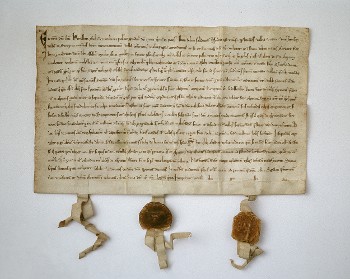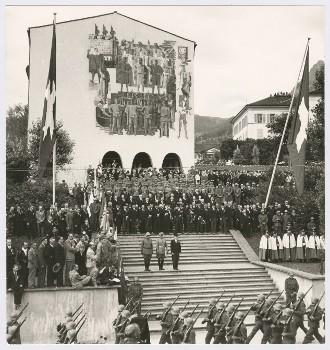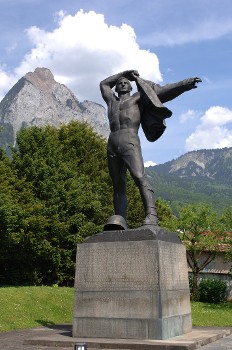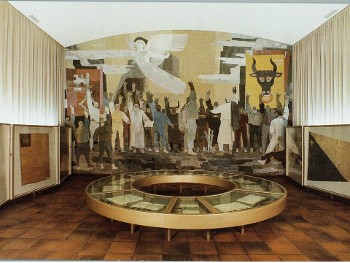History
The Museum of the Swiss Charters of Confederation (up to 1992: the Federal Charter Archive) was built in 1936 primarily to house a single object: the Federal Charter of 1291. At the time, this pact was believed to be the founding document of the Swiss Confederation and revered much like a national shrine in its purpose-built building. Over the past decades, the Museum of the Swiss Charters has transformed itself into a modern history museum. Today, it explains not only the history of the Federal Charter but also the story behind the national history and the manner of its telling.
THE FEDERAL CHARTER ARCHIVE: BUILDING NATIONAL IDENTITY

The Federal Charter of 1291.
Europe had been shaken by severe political and economic crises in the 1930s. In neutral Switzerland, too, Hitler’s seizure of power was seen as an existential threat. It was at this time of crisis that «Spiritual Defence» emerged in Switzerland. The movement was dominated by an intense focus on all that was Swiss in history, politics and culture. Values that were considered to be typically Swiss – cultural diversity, democracy, a desire for freedom, and independence – were held up against fascist and national socialist totalitarianism.

General Guisan watches the march-past of the troops in 1941.
The Federal Charter of 1291 embodied and symbolised the core values of Spiritual Defence, so it comes as little surprise that it assumed an almost sacred quality at the time of the movement. The architect behind the Museum of the Swiss Charters, Josef Beeler, also declared that his intention had been to erect a cathedral for Switzerland’s national shrine. In the exhibition hall of the Museum of the Swiss Charters, the Federal Charter was enshrined in a showcase known as the «Altar des Vaterlandes» (Altar of the Fatherland). The Federal Charter and its museum had thus become a focal point of Spiritual Defence.
ART, SYMBOLISM, PURPOSE

The «Wehrbereitschaft» (Readiness to Defend) sculpture in the museum park.
Another expression of the spirit of the 1930s is the art on and inside the Museum of the Swiss Charters. Heinrich Danioth‘s «Fundamentum» on the building’s main façade and Walter Clénin‘s «Rütlischwur» (The Oath of Rütli) both have as their subject the founding of the Old Swiss Confederacy on Rütli meadow, while Hans Brandenberger‘s monumental sculpture «Wehrbereitschaft» (Readiness to Defend) stands for the dynamism, strength and power of Switzerland and its ability to defend itself – values key to Spiritual Defence.
Alongside the symbolic role played by the building, the latter also served a practical purpose. The section to the rear of the Federal Charter Archive housed the State Archives of Schwyz, but even more important was unquestionably the museum section of the new building, where the most important documents from the collection of the State Archives were exhibited. To this day, all the documents on display in the museum – including the Federal Charter of 1291 – are the property of the State Archives and thereby the Canton of Schwyz.
THE SPIRIT OF 68: TAKEN DOWN FROM THE ALTAR

The exhibition hall in 1980.
The period of radical social change at the end of the 1960s also saw the traditional view of Swiss national history begin to waver. Soon the Federal Charter of 1291 was no longer seen as the founding document of the Swiss Confederation. The change in sentiment was reflected in the exhibition too, which was renewed in 1979. The Federal Charter of 1291 was deprived of its overwhelming importance. Taken down from its showcase on the “Altar of the Fatherland”, it was placed in a circular glass case alongside other pacts and documents – as one among many.
MYTH AND HISTORY

The Swiss Federal Charter of 1291 in the exhibition.
Moves to incorporate the latest research findings into the exhibition design were already being made in the 1990s and were finally put in place on redevelopment of the museum in 2014. The Federal Charter of 1291 may not be a founding document, but it did have a major influence on the national identity of Switzerland and its population, especially at the time of Spiritual Defence. The history of the role and influence of this document, the importance of the myth surrounding the Federal Charter of 1291, is an important aspect of the exhibition today. As a monument to Spiritual Defence, the museum too has become part of the exhibition in its own right.